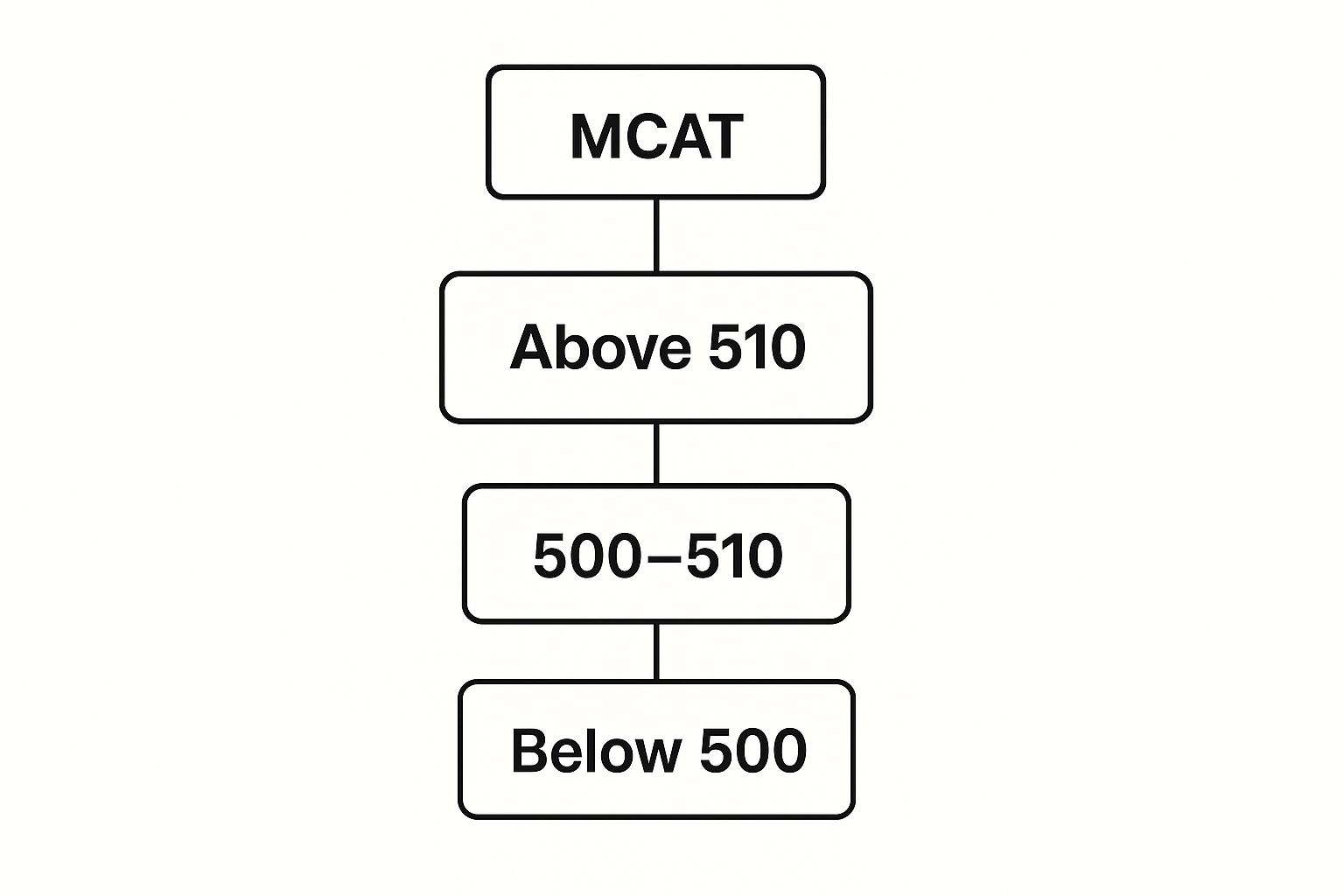So, what's a "good" MCAT score?
Let's cut right to the chase. A good score is one that makes you a competitive applicant for the medical schools on your list. While that number changes from person to person, a score of 512 or higher is what most people would consider a strong performance. Hitting that mark puts you around the 84th percentile and opens a lot of doors.
Understanding the Baseline Score for Success
Figuring out what makes a good MC-AT score isn't about landing on one magic number. It’s about understanding the difference between the average person who applies and the average person who actually gets in—what we call a matriculant.
That gap between the applicant and the matriculant tells the real story. It reveals the true level of competition and helps you set a target that’s both realistic and ambitious.
Think of it this way: just being "above average" among everyone who takes the test isn't quite enough. The MCAT score range goes from 472 to 528, and the exact middle of the pack—the 50th percentile—is a score of 500. But the data shows that getting into med school requires aiming quite a bit higher.
The Applicant vs. Matriculant Divide
During the 2019-2020 application cycle, the average MCAT score for all medical school applicants was about 506.1. That score puts you in the 61st percentile. It's a respectable score, for sure, but it's not the benchmark for getting an acceptance letter.
In contrast, the average score for students who were actually accepted into medical school was much higher, hovering around 511.5. This jumps you all the way up to the 83rd percentile, showing just how big the performance gap is between applying and matriculating. You can dive deeper into the trends in MCAT score averages to see how these numbers have evolved.
Key Takeaway: The most critical insight here is that the average accepted student scores significantly higher than the average applicant. Just aiming for the applicant average probably won't be enough to secure your spot.
To put these numbers into a clearer context, let's look at the key benchmarks side-by-side.
MCAT Score Benchmarks At a Glance
This quick table breaks down the most important score thresholds you'll hear about. Notice the significant jump from the median score to what's needed for matriculation.
| Benchmark Category | Approximate MCAT Score | Approximate Percentile Rank |
|---|---|---|
| Median Score (50th Percentile) | 500-501 | 50% |
| Average Applicant Score | ~506 | ~61% |
| Average Matriculant Score | ~512 | ~83% |
This table clearly illustrates the competitive reality of medical school admissions. The real target isn't just being better than half the test-takers; it's about performing at the level of those who successfully earn a seat.
Internalizing this difference is the first essential step in your MCAT journey. It grounds your expectations in reality and helps you frame a score goal that reflects what it truly takes to get into medical school.
Decoding Your Score and Percentile Rank

When your MCAT score report finally hits your inbox, it’s easy to focus on that one big number. But that score is so much more than a single data point—it's a detailed story of how you stack up against thousands of other ambitious pre-meds. To really understand that story, you have to break down how the exam is built.
The MCAT is made up of four distinct sections, each testing a different pillar of knowledge and reasoning essential for medical school.
They are:
- Chemical and Physical Foundations of Biological Systems (Chem/Phys)
- Critical Analysis and Reasoning Skills (CARS)
- Biological and Biochemical Foundations of Living Systems (Bio/Biochem)
- Psychological, Social, and Biological Foundations of Behavior (Psych/Soc)
Each of these sections gets its own score, ranging from 118 to 132. Your total MCAT score, which can fall anywhere from 472 to 528, is simply the sum of those four section scores. While everyone obsesses over the total, admissions committees absolutely look at the individual parts, so understanding your performance on each is crucial.
The Power of Percentiles
Just knowing you got a 510 or a 515 doesn't tell you the whole story. To truly grasp what is a good MCAT score, you need to look at its percentile rank. The percentile is what gives your score context, showing exactly how you performed relative to every other person who took the test.
Think of it like running a marathon. Your finish time is your score, but your percentile is your placement. If you finish in the 90th percentile, it means you ran faster than 90% of the other runners. It’s not just about your personal best; it's about how you performed against the competition on race day.
A higher percentile rank means you outperformed a larger percentage of test-takers, making your application stand out to admissions committees. This is why a few points on the MCAT can cause a significant jump in your percentile.
To be a truly competitive applicant, you should be aiming for a score that lands you at or above the 85th percentile. Looking at recent data from 2022-2024, a score of 512 puts you right around the 84th percentile, which can substantially boost your admission chances. This is exactly why percentiles are so critical—they translate your score into the language of competitiveness. You can dig into the full details on MCAT percentiles to see precisely how every point impacts your standing.
Why Small Point Gains Matter
Here’s something most students don't realize: the relationship between your score and your percentile isn’t linear. Because the vast majority of test-takers' scores are clustered around the average, a small improvement in that middle range can lead to a huge leap in your percentile rank.
For example, jumping from a 501 to a 506 might feel like a modest gain, but it could rocket you from the 50th percentile up to the 66th. That's a massive difference in how an admissions committee sees you.
This sensitivity makes every single point you can gain incredibly valuable. It’s a perfect illustration of why targeted, strategic prep can completely change the game. A few extra points could be the very thing that elevates your application from the middle of the pack to the top of the pile.
The Applicant vs. Matriculant Score Gap
If you want to truly understand what a good MCAT score is, you can't just look at the average score of every single person who applies to medical school. The real story—the one that matters for your chances—is in the gap between the average applicant and the average matriculant.
A matriculant is a student who doesn't just apply, but actually gets an acceptance letter and enrolls. The difference between their scores and the scores of the general applicant pool reveals the competitive benchmark you should really be aiming for.
Think of it this way: imagine two aspiring doctors. One scores a 506. That’s right around the average for all applicants, which sounds pretty good on the surface. But it also means they’re swimming in a massive, crowded pool of candidates who all look very similar on paper. The other student scores a 512, which is much closer to the average for actual matriculants.
That seemingly small six-point difference can be a game-changer.
Why This Gap Matters So Much
Let's be blunt: the MCAT is a filtering tool. Admissions committees (AdComs) are buried under tens of thousands of applications, and they use scores to quickly sort candidates. A higher score immediately signals that you can handle the academic rigor of medical school. A 512 tells a much more compelling story than a 506; it suggests a higher level of mastery and a greater likelihood of success, making that application stand out.
This gap exists for a simple reason: there are far more qualified applicants than there are available seats in U.S. medical schools. Competition is fierce and has only gotten more intense over the years.
While the average total MCAT score for all applicants recently hovered around 506.5, the average for those who successfully matriculated was a much higher 511.9—that’s the 83rd percentile. If you want to dive deeper into the numbers, you can explore detailed AAMC score statistics to see this competitive trend for yourself.
Key Insight: Scoring above the applicant average is the bare minimum. Your real goal should be to score at or above the matriculant average. This is the score that proves you don't just want to apply—you are ready to succeed.
The image below gives you a clear visual of how these scores break down into different competitive tiers.

As you can see, hitting a score above 510 pushes you into a much more competitive bracket, significantly boosting your chances of getting that acceptance letter.
Ultimately, closing the gap between the applicant and matriculant averages should be a primary goal of your MCAT prep. It’s not just about passing a test; it’s about positioning yourself as a top-tier candidate that AdComs can't afford to ignore.
How Admissions Committees Use Your Score

Once you hit "submit" on your medical school application, your MCAT score doesn't just disappear into a database. It begins a critical journey, landing on the desks of admissions committee members who have a monumental task ahead of them.
So, what really happens behind those closed doors? How does this single number fit into the rich tapestry of your life experiences, essays, and grades?
Think of the MCAT as a great equalizer. Admissions committees (AdComs) are tasked with sorting through thousands of applications from countless different universities. They see applicants with wildly different GPAs, diverse academic backgrounds, and unique majors. The MCAT provides a standardized, objective yardstick to compare everyone fairly.
The First Hurdle Your Score Must Clear
Let's be real. Nearly every medical school practices a "holistic review"—they truly do want to see every part of your application. But a strong MCAT score is often the key that unlocks the door for that deeper look.
With a flood of applications to manage, many schools use initial MCAT and GPA cutoffs as a screening tool. It's a practical necessity. If your scores fall below a certain threshold, your application might be filtered out before it ever receives a full, human review.
This isn't meant to diminish the importance of your story, but to highlight a crucial reality of the process. A competitive score ensures your beautifully crafted essays and impactful experiences actually get read by the committee. It’s the first proof point that you have the foundational knowledge to handle the demanding medical school curriculum.
The Score's Role: Your MCAT score acts as an academic credential, validating your GPA and signaling to admissions committees that you are prepared for the rigors of their program. A high score can help offset a lower GPA, while a low score can raise questions even for a student with a perfect 4.0.
Beyond the Total Score: Balance Is Key
AdComs don't just glance at your total score; they scrutinize the breakdown. What they really want to see is a well-rounded applicant, and your section scores provide that insight. A balanced performance across all four sections is the ideal.
A major red flag for committees is a lopsided score profile. For instance, a very high total score that’s been dragged down by one particularly low section score can cause concern. A rock-bottom CARS score (think below 125) might suggest a weakness in the kind of critical reasoning and reading comprehension that is absolutely essential for diagnosing patients.
Ultimately, your MCAT score works in concert with every other piece of your application. It’s rarely the sole factor, but it’s a powerful one that sets the stage for how the rest of your story is received.
Setting a Smart MCAT Score Goal
So, what’s a "good" MCAT score? The honest answer is that there’s no single magic number. A good score is a strategic one—a target tailored specifically to your academic background and the medical schools you dream of attending.
Forget chasing a generic number. The real goal is to turn that intimidating three-digit score into a personalized, achievable benchmark. Let's walk through how to do that.
Your first move is to put on your detective hat. The best tool for the job is the AAMC's Medical School Admission Requirements (MSAR) database. Think of it as a treasure map. It shows you the median MCAT scores and GPAs for the entering classes at nearly every medical school in the country.
Start by making a realistic list of schools—your reaches, your solid contenders, and your safeties. Then, dive into the MSAR and pull the data for each one.
Pro Tip: Aiming for a score at or slightly above the median for your target schools gives you a strong competitive edge. If a school’s median MCAT is a 514, that number should be your absolute minimum target for that program.
Balancing Your GPA and MCAT
Next, you need to take an honest look at your Grade Point Average (GPA). Your GPA and MCAT score are like two sides of a scale; they exist in a delicate balance. Admissions committees look at both to figure out if you can handle the academic rigor of medical school.
A high GPA can act as a cushion, giving you a little breathing room if your MCAT score isn't perfect. On the flip side, a stellar MCAT score can do a lot of heavy lifting to compensate for a GPA that's on the lower end of a school's typical range.
It breaks down like this:
- High GPA (e.g., 3.8+): You're already in a great position. A competitive MCAT score will confirm what your grades suggest—that you're a strong academic candidate.
- Lower GPA (e.g., below 3.5): Your MCAT score becomes absolutely critical. A high score is your chance to prove you've mastered the material and can crush challenging science coursework, even if your earlier grades don't fully reflect it.
Don't forget to factor in your state residency. Public, in-state medical schools often have slightly lower median MCAT scores for residents compared to out-of-state applicants. This detail can shape your school list and, in turn, your score goal.
By combining school research with a candid look at your GPA, you can move from a vague hope to a clear, strategic objective. Building a solid plan is key, and a well-structured MCAT study plan is what will bridge the gap between where you are now and the score you need to achieve.
What to Do When Your Score Isn't Enough

Seeing a lower-than-expected MCAT score pop up on your screen can feel like a gut punch. It’s easy to feel like this one number just closed the door on your dream of becoming a doctor. But before you spiral, take a breath. A disappointing score is a roadblock, not a dead end.
Your next moves, however, have to be smart. Rushing back into studying without a plan is a recipe for the same outcome. The first, most critical step is an honest, unflinching look at what went wrong.
Ask yourself the hard questions. Did your official score match your practice exam performance? A significant drop might point to test-day anxiety being the real culprit. Managing your nerves is just as important as knowing the content, and exploring strategies to reduce test anxiety can be a game-changer.
Building a New Plan of Attack
Once you have a better idea of why your score was low, it's time to build a completely new game plan. Simply logging more hours with the same old methods won't cut it. You need to study smarter, not just harder.
- Dig Into Your Score Report: Don't just glance at the total. Your AAMC score report is a goldmine of data. Pinpoint the specific sections and even the sub-sections where your performance dipped. This is your new study roadmap.
- Overhaul Your Study Method: Did you spend most of your time buried in content review books? It might be time to pivot. Shift your focus heavily toward practice questions and full-length exams to build the mental stamina and test-taking instincts you'll need.
- Find Fresh Resources: Sometimes you just need a new perspective. Consider trying different prep materials, joining a study group, or even hiring a tutor to help you break through plateaus on difficult topics.
If you’re looking for a more structured way to tackle a retake, getting specific advice on https://acemedboards.com/how-to-improve-mcat-score/ can provide targeted techniques to shore up your weaknesses.
Crucial Insight: Only plan a retake if you are genuinely confident you can achieve a significant score increase. Medical schools see all of your attempts. A jump of just one or two points probably isn't worth the time, money, and stress.
Exploring Alternatives to an Immediate Retake
Sometimes, the smartest move isn't to retake the MCAT at all—at least, not right away. You can use this time to strengthen other areas of your application, making your less-than-ideal score a smaller piece of the overall puzzle.
Consider enrolling in a post-baccalaureate program to give your science GPA a serious boost. Or, you could dedicate a gap year to gaining more meaningful clinical or research experience. These actions show admissions committees that you have the resilience and dedication to succeed—qualities that a single test score can't always measure.
Answering Your Top MCAT Score Questions
As you get deeper into the world of medical school admissions, you'll start having some very practical questions about the MCAT. It’s not just about knowing the science; you have to understand the rules of the game. Let's clear up some of the most common questions that pop up.
How Many Times Can I Take the MCAT?
The AAMC has some pretty clear rules here, and they're in place to make sure every attempt is a serious, well-prepared one.
Here’s the breakdown of how many times you can sit for the exam:
- Up to three times in a single calendar year.
- Up to four times over a two-year period.
- A grand total of seven times in your entire life.
Remember, every single one of your scores is visible to medical schools. This isn't a test where you can just delete a bad score and pretend it never happened. Because of this, you need to be strategic. Don't retake the test just to chase a few extra points. You should only go for a retake if you're absolutely confident you can make a significant jump in your score.
Think Strategically About Retakes: A tiny bump in your score probably isn't worth the time, money, and stress of a retake. The goal is to show a clear, upward trend that demonstrates your commitment and improved mastery, not just persistence.
Do MCAT Scores Expire?
Yes, they do. Your MCAT score has a definite shelf life. For most medical schools, a score is considered too old if it's more than three years old when you submit your application. So, if you're applying in the 2025-2026 cycle, you'll almost certainly need a score from 2022 or later.
This policy exists to ensure that your score is a recent and accurate reflection of your knowledge. But don't take this as a universal rule—always, always double-check the specific requirements for every single school on your list. Some might have slightly different time windows.
Is a Balanced Score Better?
Absolutely. Admissions committees love to see consistency. You could have a fantastic total score, but if one of your section scores is glaringly low—especially anything below 125—it can be a major red flag. An unbalanced score like that can signal a significant academic weakness in a core area.
A balanced score profile shows that you're well-rounded and proficient across all the foundational sciences and critical thinking skills. That’s why a slightly lower but consistent score is often seen as much stronger than a higher, lopsided one. Making sure you have a solid approach with proven MCAT test-taking strategies is key to performing consistently across all four sections.
At Ace Med Boards, we specialize in turning questions into confidence. Our expert tutors provide personalized guidance to help you master the MCAT, balance your section scores, and achieve a result that makes your application shine. Learn how our tailored support can make the difference.
